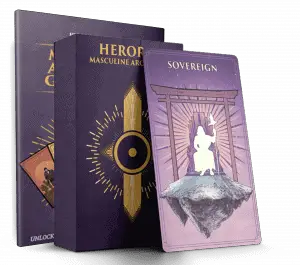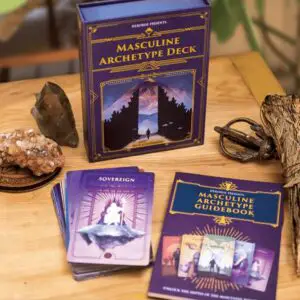The Jester archetype is often portrayed as a fool or a clown and is associated with chaos and spontaneity. Jesters are entertaining, but they can also be disruptive and even dangerous.
They are the embodiment of change and can teach us a lot about ourselves if we are willing to listen.
In this blog post, we will explore the Jester archetype in more depth, and discuss what it can teach us about our own lives.
What Is The Jester Archetype?
The Jester archetype is one of the twelve Jungian archetypes. It represents chaos, fun, and play. Jesters often appear in stories to lighten the mood or to provide comic relief. They are often masters of verbal irony and sarcasm.
READ MORE: What are Archetypes and are they real?
Everyone has access to the different Archetypes. They represent different aspects of our psyche that we can access depending on the situation.
Jesters often show up when we need to lighten up and help process difficult emotions in a healthy way.

Jester Archetype Characteristics
Jesters are known for their ability to mock authority. They can be a thorn in the side of those in power and are not afraid to speak their mind.
Jesters are often irreverent and unpredictable. They can be a refreshing change of pace in stories that are otherwise dark or serious.
Jesters often serve as a reminder that life is meant to be enjoyed. They help us to lighten up and have some fun.
Here is a list of characteristics of the Jester Archetype.
| Traits | Drive | Fear | Strategy |
| ○ Humorous ○ Positivity ○ Comedic ○ Cheerful | ○ Laughter ○ Happiness ○ Play ○Enjoyment | ○ Boredom ○ Despair ○ Overly Serious ○ Negativity | ○ Play as a way of discovering. ○ Humor to open people up. |
The Jester archetype can be helpful for people who feel like they need to lighten up their lives.
If you feel like you’re taking life too seriously, the Jester archetype can be a great way to inject some chaos and fun into your life.
Jesters can also help you to learn how to laugh at yourself and not take things so seriously.
The Jester is also similar to the Comedian Archetype from the HeroRise Masculine Archetype Deck.
Shadow Aspects of the Jester
Each of the archetypes also has a shadow. The Shadow is the parts of your personality that you don’t want to see or acknowledge and keep hidden.
The Jester has a shadow aspect that can be very destructive. This aspect can be very chaotic and out of control. It can also be quite mean and insulting. This part of the Jester can be very destructive and can cause a lot of damage.
It is important to be aware of the shadow aspects of the Jester archetype and work to keep them under control.
Shadow Aspects of the Jester Archetype:
- Chaotic
- Out of control
- Mean
- Insulting
- Destructive
- Causes damage
READ MORE: Basics of Shadow Work
It’s important to become aware of the shadow aspects of the Jester. You can integrate these aspects of the archetype into your personality in a healthy way. This will help you to avoid the negative consequences of these aspects.
Pop Culture Examples Of The Jester
Archetypes are universal patterns that show up again and again in movies, literature, and art. The Jester can be seen in lots of films and is a crucial part of many stories.

Here are some examples of the Jester Archetype:
- Donkey from Shrek is a great example of the Jester. In the story, he is always making jokes and trying to lighten the mood. He also helps Shrek find his way when he’s lost.
- Ferris Bueller from Ferris Bueller’s Day Off is another great example of the Jester. He’s always trying to have a good time and make everyone else happy, even if it means breaking the rules. His carefree personality both causes chaos and joy to a lot of characters in the film.
- Jack from Jack and the Beanstalk is a classic Jester character. He uses his wit and humor to get out of tricky situations, and he always puts a smile on everyone’s face.
- Jamal Walker from Black Night is a modern Jester character. He’s always making jokes and trying to keep everyone happy, even in the face of danger.
- Joey from the show Friends is a Jester character who always provides comic relief in the show. His character also demonstrated the shadow aspects of the Jester. He has a hard time growing outside of his youth and always struggled with intimacy.
These are just a few examples of the Jester archetype in pop culture. There are many more films, books, and TV shows that feature this type of character.
Example of The Jester Archetype For Brands
Archetypes are aspects of the human psyche, but they can also be seen in brand identities.
Many brands use the Jester archetype to convey a sense of fun and playfulness. GEICO is a great example because it uses a variety of humor in its ads, from slapstick to puns. The Jester is also often used by brands that want to come across as young and trendy, like Virgin Mobile or Target.
Jester Archetype Brands:
- GEICO
- Target
- M&M’s
- Domino’s Pizza
Attributes of Jester brand voice:
- Playful
- Optimistic
- Whimsical
One downside of the Jester archetype is that it can be seen as superficial or flippant. If a brand doesn’t back up its sense of fun with substance, it can be easily forgotten.
When used correctly, the Jester archetype can be a great way to connect with customers and make a brand stand out. It’s important to be aware of the risks, however, and make sure that you’re putting real effort into the fun and games. Otherwise, you might just end up looking like a fool.
Strengthening Your Jester Archetype
We all have access to the Jester Archetype as one aspect of our total personality. At some points of our lives, the Jester is strong and in balance, while at other points you might feel disconnected from it.
This disconnection can come from your upbringing, culture, or current life circumstances. If you want to strengthen your Jester Archetype, here are some tips:
- Find a creative outlet. By making time for expression every week you will be able to practice the carefree nature of the Jester. It can be anything from painting to writing to dancing.
- Spend time with friends and family. The Jester loves social interaction, so make sure you get out and spend time with people you love. Laughing and being playful are some of the best ways to connect with this archetype.
- Get out in nature. The Jester loves to explore and be surrounded by beauty. Spending time outside will help you connect with this aspect of yourself.
- Connect with your Inner Child. Spend time playing and being silly. This will nurture the Jester and help you access this aspect of yourself more easily.
The Jester Archetype is an important part of who we are and by nurturing it, we can bring more joy and light into our lives. When we are in balance, the Jester can help us see the humor in life and find more joy every day.
In Conclusion:
Archetypes may be an important tool for examining your own personality and provide insights into the many aspects of your identity.
The Jester is but one of the 12 Jungian Archetypes. It is important to explore all the archetypes to gain a better understanding of yourself.
If you are interested in learning more about the Archetype, I encourage you to check out the Masculine Archetype Deck, as well as the following articles:





